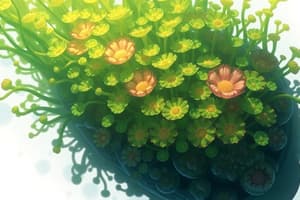Podcast
Questions and Answers
What is the primary role of algae in aquatic ecosystems?
What is the primary role of algae in aquatic ecosystems?
- Transporters of nutrients
- Primary producers (correct)
- Predators of small fish
- Decomposers of organic matter
Which of the following is NOT a type of algae?
Which of the following is NOT a type of algae?
- Fungi (correct)
- Phaeophyta
- Cyanobacteria
- Chlorophyta
Which reproductive strategy do algae commonly use to increase their numbers?
Which reproductive strategy do algae commonly use to increase their numbers?
- Conjugation with other species
- Budding off from parental organisms
- Asexual reproduction via binary fission (correct)
- Sexual reproduction through flowering
How do algal blooms primarily affect aquatic ecosystems?
How do algal blooms primarily affect aquatic ecosystems?
What potential use does algae have in renewable energy?
What potential use does algae have in renewable energy?
In which environment can algae thrive?
In which environment can algae thrive?
What significance do algae have in monitoring environmental conditions?
What significance do algae have in monitoring environmental conditions?
Which of the following describes a main challenge facing algae today?
Which of the following describes a main challenge facing algae today?
Flashcards are hidden until you start studying
Study Notes
Overview of Algae
- Definition: Algae are a diverse group of photosynthetic organisms found in various aquatic environments.
- Classification: Algae are classified into several groups, including:
- Chlorophyta (Green algae)
- Rhodophyta (Red algae)
- Phaeophyta (Brown algae)
- Bacillariophyta (Diatoms)
- Cyanobacteria (Blue-green algae)
Characteristics
- Photosynthesis: Algae contain chlorophyll and other pigments, enabling them to perform photosynthesis.
- Morphology: Can be unicellular (e.g., diatoms) or multicellular (e.g., seaweeds).
- Habitat: Primarily aquatic; can live in freshwater, marine, and even damp terrestrial environments.
Ecological Role
- Primary Producers: Algae are essential in aquatic food webs, serving as primary producers.
- Oxygen Production: Contribute significantly to global oxygen production through photosynthesis.
- Habitat Formers: Provide structure and habitat for various marine organisms.
Economic Importance
- Food Source: Used in human diets (e.g., seaweed, spirulina) and animal feed.
- Biofuels: Potential source of renewable energy via biofuel production.
- Pharmaceuticals: Source of compounds for medicines, cosmetics, and supplements.
- Fertilizers: Algal extracts used in agriculture for soil enhancement.
Environmental Indicators
- Water Quality: Algal blooms can indicate nutrient pollution; they can disrupt ecosystems and water quality.
- Eutrophication: Excess nutrients lead to rapid algal growth, resulting in oxygen depletion in water bodies.
Reproductive Strategies
- Asexual Reproduction: Common method through binary fission, fragmentation, or spore formation.
- Sexual Reproduction: Involves gametes; can promote genetic diversity.
Challenges
- Climate Change: Affects algal growth patterns and distribution.
- Invasive Species: Some algae can become invasive, impacting local biodiversity and ecosystems.
Research and Future Directions
- Genetic Studies: Understanding genetic diversity for conservation efforts and biotechnology applications.
- Bioremediation: Investigating the use of algae for cleaning pollutants from water bodies.
Summary
Algae play a crucial role in ecosystems, economy, and human health. Their diverse forms and functions make them vital components of both aquatic and terrestrial environments, while their responses to environmental changes are significant for ecological monitoring and conservation strategies.
Overview of Algae
- Algae are photosynthetic organisms that inhabit various aquatic settings, showcasing a wide diversity.
- Major classifications include:
- Chlorophyta - Green algae, known for their chlorophyll.
- Rhodophyta - Red algae, often found in warmer seas.
- Phaeophyta - Brown algae, large forms such as kelp.
- Bacillariophyta - Diatoms, characterized by their unique silica cell walls.
- Cyanobacteria - Blue-green algae, microorganisms with photosynthetic capabilities.
Characteristics
- Algae are equipped with chlorophyll and pigments for effective photosynthesis.
- Morphologically, they can be unicellular (e.g., diatoms) or multicellular (e.g., seaweeds).
- Algae thrive in aquatic environments including freshwater, marine ecosystems, and moist land.
Ecological Role
- Serve as primary producers in aquatic food webs, converting light into energy.
- Contribute to significant global oxygen generation during photosynthesis.
- Act as critical habitat formers, providing dwelling spaces for diverse marine life.
Economic Importance
- A food source for humans (e.g., seaweed, spirulina) and livestock.
- Present opportunities for biofuel development, contributing to renewable energy solutions.
- Source of bioactive compounds utilized in pharmaceuticals, cosmetics, and dietary supplements.
- Algal extracts enhance soil quality in agricultural practices.
Environmental Indicators
- Algal blooms can signal nutrient over-enrichment in water systems, potentially harming ecosystems.
- Eutrophication results from nutrient overload, which can lead to oxygen depletion and aquatic life threats.
Reproductive Strategies
- Asexual reproduction is prevalent, utilizing methods like binary fission and spore formation.
- Sexual reproduction involves gametes, fostering genetic diversity among algal populations.
Challenges
- Climate change impacts algal growth and geographical distribution, posing ecological risks.
- Invasive algal species can disrupt local ecosystems and threaten native biodiversity.
Research and Future Directions
- Genetic studies aim to enhance knowledge of algal biodiversity and inform conservation efforts.
- Bioremediation research explores algae's potential for pollutant removal from aquatic systems.
Summary
- Algae are integral to ecosystems, economies, and human health, and their diverse functions are crucial for environmental stability and monitoring. Their adaptations to environmental challenges highlight their importance in conservation strategies.
Studying That Suits You
Use AI to generate personalized quizzes and flashcards to suit your learning preferences.




